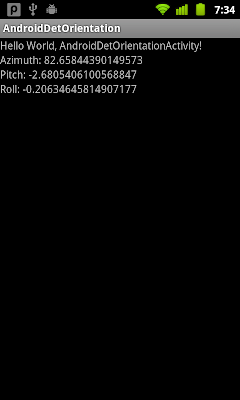Example:

package com.AndroidDetOrientation;
import android.app.Activity;
import android.hardware.Sensor;
import android.hardware.SensorEvent;
import android.hardware.SensorEventListener;
import android.hardware.SensorManager;
import android.os.Bundle;
import android.widget.TextView;
public class AndroidDetOrientationActivity extends Activity
implements SensorEventListener{
SensorManager sensorManager;
private Sensor sensorAccelerometer;
private Sensor sensorMagneticField;
private float[] valuesAccelerometer;
private float[] valuesMagneticField;
private float[] matrixR;
private float[] matrixI;
private float[] matrixValues;
TextView readingAzimuth, readingPitch, readingRoll;
/** Called when the activity is first created. */
@Override
public void onCreate(Bundle savedInstanceState) {
super.onCreate(savedInstanceState);
setContentView(R.layout.main);
readingAzimuth = (TextView)findViewById(R.id.azimuth);
readingPitch = (TextView)findViewById(R.id.pitch);
readingRoll = (TextView)findViewById(R.id.roll);
sensorManager = (SensorManager)getSystemService(SENSOR_SERVICE);
sensorAccelerometer = sensorManager.getDefaultSensor(Sensor.TYPE_ACCELEROMETER);
sensorMagneticField = sensorManager.getDefaultSensor(Sensor.TYPE_MAGNETIC_FIELD);
valuesAccelerometer = new float[3];
valuesMagneticField = new float[3];
matrixR = new float[9];
matrixI = new float[9];
matrixValues = new float[3];
}
@Override
protected void onResume() {
sensorManager.registerListener(this,
sensorAccelerometer,
SensorManager.SENSOR_DELAY_NORMAL);
sensorManager.registerListener(this,
sensorMagneticField,
SensorManager.SENSOR_DELAY_NORMAL);
super.onResume();
}
@Override
protected void onPause() {
sensorManager.unregisterListener(this,
sensorAccelerometer);
sensorManager.unregisterListener(this,
sensorMagneticField);
super.onPause();
}
@Override
public void onAccuracyChanged(Sensor arg0, int arg1) {
// TODO Auto-generated method stub
}
@Override
public void onSensorChanged(SensorEvent event) {
// TODO Auto-generated method stub
switch(event.sensor.getType()){
case Sensor.TYPE_ACCELEROMETER:
for(int i =0; i < 3; i++){
valuesAccelerometer[i] = event.values[i];
}
break;
case Sensor.TYPE_MAGNETIC_FIELD:
for(int i =0; i < 3; i++){
valuesMagneticField[i] = event.values[i];
}
break;
}
boolean success = SensorManager.getRotationMatrix(
matrixR,
matrixI,
valuesAccelerometer,
valuesMagneticField);
if(success){
SensorManager.getOrientation(matrixR, matrixValues);
double azimuth = Math.toDegrees(matrixValues[0]);
double pitch = Math.toDegrees(matrixValues[1]);
double roll = Math.toDegrees(matrixValues[2]);
readingAzimuth.setText("Azimuth: " + String.valueOf(azimuth));
readingPitch.setText("Pitch: " + String.valueOf(pitch));
readingRoll.setText("Roll: " + String.valueOf(roll));
}
}
}
<?xml version="1.0" encoding="utf-8"?>
<LinearLayout xmlns:android="http://schemas.android.com/apk/res/android"
android:layout_width="fill_parent"
android:layout_height="fill_parent"
android:orientation="vertical" >
<TextView
android:layout_width="fill_parent"
android:layout_height="wrap_content"
android:text="@string/hello" />
<TextView
android:id="@+id/azimuth"
android:layout_width="fill_parent"
android:layout_height="wrap_content"/>
<TextView
android:id="@+id/pitch"
android:layout_width="fill_parent"
android:layout_height="wrap_content"/>
<TextView
android:id="@+id/roll"
android:layout_width="fill_parent"
android:layout_height="wrap_content"/>
</LinearLayout>
Next
- Create our Android Compass
have you noticed, that the values after Math.toDegrees() are not the same than the ones from orientationSensor and needs to get "normalized"?
ReplyDelete